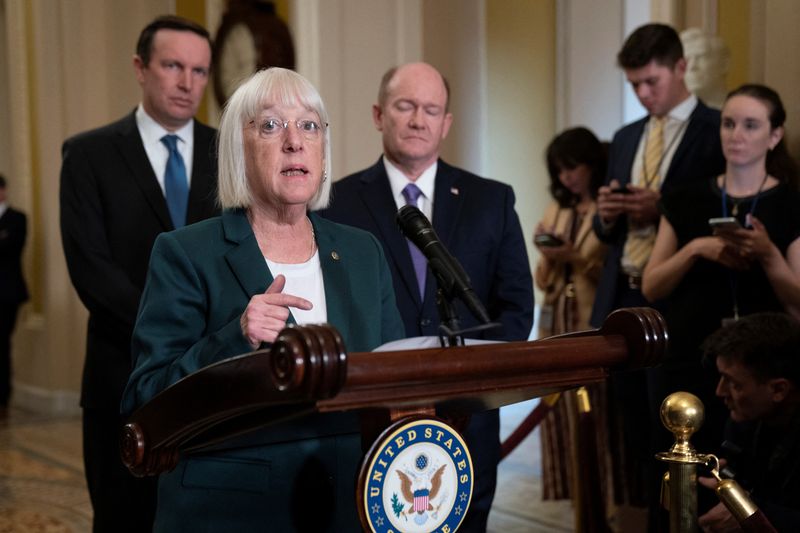Top US congressional Democrat on spending says Republicans dragging feet
2023.12.06 16:46

© Reuters. U.S. Senator Patty Murray (D-WA) speaks to reporters after the weekly senate party caucus luncheons at the U.S. Capitol in Washington, D.C., U.S., November 7, 2023. REUTERS/Sarah Silbiger/File Photo
By Richard Cowan and Moira Warburton
WASHINGTON (Reuters) – The Democratic chair of the U.S. Senate committee that sets spending policy on Wednesday said Republican House Speaker Mike Johnson was blocking his chamber’s team from negotiating budget details in hopes of holding spending to last year’s levels.
Senate Appropriations Committee Chair Patty Murray said in an interview that she believed Johnson was standing in the way of his negotiators agreeing on spending levels for the 12 individual bills needed to fund many of the federal government’s operations.
Democratic President Joe Biden and Johnson’s Republican predecessor, Kevin McCarthy, in June agreed on a $1.59 trillion overall level of discretionary spending for the fiscal year that began Oct. 1, leaving it to lawmakers to divvy that up across the government’s sprawling operations.
“What he (Johnson) has not done is given direction to his Appropriations Committee to start negotiating the bills between the House and the Senate,” Murray said.
The federal government is currently operating on a temporary “continuing resolution,” or CR, holding funding steady at last year’s levels. That money will begin to run out next month, and without further action by Congress, the federal government would enter a partial shutdown.
“What the speaker has thrown out is some kind of solution of a date-change, full-year CR,” Murray said, meaning current funding would be extended through the full federal fiscal year ending Sept. 30, 2024.
A spokesman for Johnson said: “The speaker’s preference is a fulsome process producing full-year bills, but we need to be done with FY24 one way or another.”
The Republican-controlled House of Representatives so far has passed only seven of the 12 bills in partisan votes, failing to address some of the thorniest issues, such as annual food and agriculture funding and Justice Department funding, as well as money for transportation, scores of social programs and others.
In the Democratic-majority Senate, Murray’s committee has passed all 12 bills with strong bipartisan support, while the full chamber has passed just three.
FUNDS RUN OUT NEXT MONTH
The stopgap CR currently in place begins to run out on Jan. 19, including services for veterans, transportation and housing, with all other funding expiring by Feb. 2.
If Johnson were to insist on a full-year CR instead of those 12 bills that make spending changes throughout the government, the Senate could balk, Murray said.
“I am ready to go based on the number we all agreed to; voted into law … and now he is saying, ‘Wait, wait, I’m not going to let my House Appropriations Committee negotiate with you until we have a new, different agreement.’ We’re at the end of the (calendar) year, or three months into this (fiscal) year and now he’s trying to negotiate new numbers. That is nuts,” Murray said.
Murray’s Republican counterpart, Senator Susan Collins, also said that holding funding steady for the year would harm the nation, including its military readiness.
“A yearlong continuing resolution would simply fail to provide the resources needed to protect our nation,” Collins said in a Nov. 29 speech to the Senate.
Two House Republican appropriators, Representatives Tom Cole and Michael Simpson, on Wednesday held out hope that a deal can be reached soon on a new top-line spending number, setting the stage for House-Senate negotiations over Congress’ winter break, which is scheduled to begin at the end of next week.
Biden and McCarthy agreed on the $1.59 trillion top-line discretionary spending number as part of a June deal that narrowly averted a historic default on the nation’s debt, which would have destabilized financial markets. McCarthy in October was ousted by members of his own party after reaching a stopgap spending deal with Democrats that averted a partial government shutdown.
The U.S. in the fiscal year ended Sept. 30 posted a $1.7 trillion deficit, its largest outside of the peak of the COVID-19 pandemic, driving its total debt past $33 trillion. That reflects both the effects of high spending and tax cuts.
Moody’s (NYSE:) ratings agency last month changed its outlook on the United States’ creditworthiness to “negative” from “stable,” citing political dysfunction.








